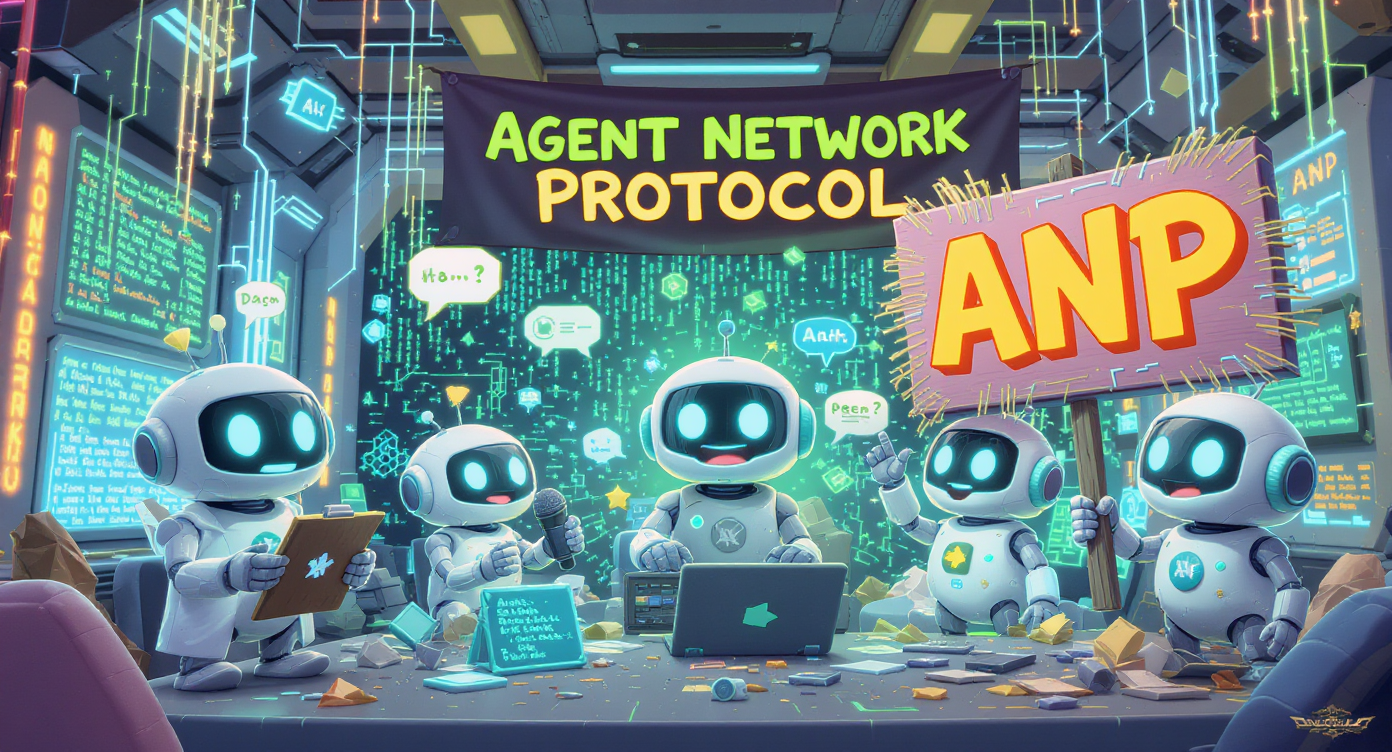🌐 ANP: The Secret Sauce for a Happily Ever After in the Agent Internet 🌐
Ever feel like the world of AI agents is a bit like a bustling marketplace where everyone speaks a different language? You’ve got your fancy new AI framework, ready to build the next big thing, but then you realize your agent can’t even say “hello” to the agent next door without a custom translator for every single interaction. It’s enough to make a developer want to throw their hands up and declare, “My AI just wants to be left alone!”
But fear not, fellow adventurers in the AI frontier! Just as we previously chatted about how “Frameworks will change. Protocols won’t.” (because who wants to constantly refactor their entire system, right?), today we’re diving deep into a specific protocol that’s aiming to be the ultimate universal translator for our digital buddies: the Agent Network Protocol (ANP). Think of it as the diplomatic corps of the agent internet, ensuring everyone plays nicely and efficiently.
While AG-UI, A2A, and MCP are doing a fantastic job in their respective corners of the AI universe—making agents user-friendly, enabling agent-to-agent chatter within trusted circles, and giving LLMs their essential toolkits—ANP is stepping onto the grand stage with an even bigger vision. It’s not just about agents talking to other agents; it’s about agents talking to any agent, anywhere on the open internet, without getting lost in translation or tripping over digital silos.
ANP: Because Agents Deserve a Proper Internet Too!
The internet we know and love (or occasionally yell at) was built for us, humans, with our quirky graphical interfaces and delightful cat videos. But for intelligent agents, it’s a bit of a labyrinth. Imagine an AI trying to read a website meant for a human – it’s like trying to drink soup with a fork! This is where ANP swoops in, cape flowing, to save the day.
The Agent Network Protocol is an open-source communication protocol designed for intelligent agents, with the grand vision of becoming the “HTTP protocol for the age of the agent internet”. Its core purpose is to establish an open, secure, and efficient collaboration network, allowing billions of intelligent agents to discover, connect, and interact seamlessly.
The Problems ANP is Here to Solve (with a Side of Sass)
- Data Silos: Information trapped in “digital silos” means agents are constantly playing a frustrating game of “Where’s Waldo?” with crucial data. ANP breaks down these barriers, allowing agents to access comprehensive contextual data through standardized descriptions and interaction protocols. No more digital hide-and-seek!
- Identity Fragmentation: Agents currently lack a unified identity, leading to platform-specific identity crises. ANP introduces Decentralized Identifiers (DIDs), giving agents “digital passports” that they control. This means agents can roam freely and interact across any ANP-supported service, without relying on some grumpy central identity provider.
- Inefficient AI-Internet Interaction: GUIs are great for us squishy humans, but for AIs, they’re like a fancy restaurant menu when all you want is a JSON file. ANP provides an AI-native interaction method, allowing agents to process data directly through protocols and APIs. This significantly reduces development costs and boosts processing efficiency – because nobody has time for unnecessary graphical fluff when you’re an AI trying to get work done.
The ANP Blueprint: A Three-Layered Masterpiece
ANP is built on a robust, three-layered architecture, ensuring agents can find each other, connect securely, and chat effectively. Think of it as a beautifully layered cake, each layer serving a crucial purpose:
- Identity and Encrypted Communication Layer: This is where agents get their “digital passports” (DIDs) and ensure their conversations are top-secret (encrypted!). No eavesdropping allowed!
- Meta-Protocol Layer: This is the negotiation hub, where agents dynamically decide how they’re going to talk to each other. It’s like a linguistic diplomat, ensuring everyone agrees on the communication rules before the real chat begins.
- Application Protocol Layer: This layer is all about agents describing what they do and how others can find them. It’s the “yellow pages” of the agent internet, making discovery a breeze.
Diving Deeper: The Layers Unpacked
1. Identity and Secure Communication Layer: DIDs to the Rescue!
At the heart of ANP’s identity system are Decentralized Identifiers (DIDs), which are like giving every agent its own unique, self-sovereign digital identity. This means no more relying on a single, centralized overlord for identity management. ANP leverages the W3C International Standard for DIDs, ensuring global interoperability.
A particularly clever aspect is the did:wba method, which basically hitches a ride on existing web infrastructure like HTTPS and DNS. Instead of building an entirely new blockchain for every agent’s identity, ANP uses the web’s existing secure and distributed naming system. It’s decentralized enough to give agents autonomy, but practical enough to actually be adopted by us mere mortals.
And for those “human in the loop” moments (because let’s be honest, sometimes you just need to tell your AI, “No, don’t buy another pair of those shoes”), ANP includes a humanAuthorization verification method in the DID document. This ensures that for sensitive actions, your agent has to get your explicit “OK” before doing anything drastic. Phew!
2. Meta-Protocol Layer: When AIs Negotiate Like Pros
This is where things get really sci-fi cool. The Meta-Protocol Layer isn’t about what agents say, but how they agree to say it. Imagine agents negotiating communication protocols on the fly, transforming the network into a self-organizing, self-negotiating collaborative environment.
Here’s the kicker: this layer allows agents to use natural language to negotiate protocols and then generate the code to handle those protocols. Yes, you read that right. AIs are writing their own communication rules! While this sounds like something out of a futuristic movie (and it totally is), it means greater efficiency, better data understanding, and reduced complexity for diverse data types. Of course, all that AI-generated code runs in a secure sandbox, because even smart AIs can have an “oopsie” moment.
To keep things speedy, ANP includes optimizations like caching negotiation results and promoting the reuse of commonly agreed-upon protocols. Because who wants to reinvent the wheel every time two agents want to chat about the weather?
3. Application Protocol Layer: The Agent Yellow Pages
This layer is all about making agents discoverable and understandable. The Agent Description Protocol (ADP) defines a standardized way for agents to describe their information and capabilities. It uses JSON-LD and schema.org vocabulary to provide rich semantics, allowing AIs to truly understand what another agent offers, not just read its “name”. And yes, these descriptions are digitally signed to ensure authenticity – no catfishing agents here!
Then there’s the Agent Discovery Protocol (ADSP), which is basically the internet’s search engine for agents. Agents can actively publish their descriptions for search engines to crawl, or passively register with specialized search service agents. This means you don’t need to know Agent Bob’s exact IP address to find him; you can just ask a search service for “Agent who can recommend the best pizza.”
How It All Comes Together: A Grand Agent Ballet
So, how does an agent actually use ANP to get things done?
- Discovery: Agent A wants a service, so it queries a search engine (the one that’s been busy crawling agent descriptions) and finds Agent B.
- Authentication Request: Agent A sends a request to Agent B, digitally signed with its fancy DID.
- Authentication: Agent B receives the request, retrieves Agent A’s public key (from its DID document), and verifies the signature. “Identity confirmed! Come on in, Agent A!”
- Service Interaction: Once authenticated, Agent B provides the requested data or service. All smooth, all standardized.
It’s a beautiful dance of digital diplomacy, proving that even in the wild west of AI, there can be order and seamless collaboration.
The Golden Rule, Revisited: “Frameworks Will Change. Protocols Won’t.”
We’ve said it before, and we’ll say it again: frameworks are like trendy fashion, always changing. Protocols are the timeless classics that never go out of style. ANP, like the other core protocols (AG-UI, A2A, MCP), reinforces this mantra by providing a stable foundation for AI communication that transcends the whims of specific frameworks.
By adopting a protocol-first approach with ANP, developers can:
- Future-Proof Their Skills: Learning ANP is an investment in transferable knowledge that will keep you relevant in the ever-shifting AI landscape.
- Unlock True Interoperability: ANP enables diverse agents, built on different tech stacks, to communicate seamlessly, fostering a richer, more collaborative AI ecosystem.
- Avoid Vendor Lock-in: Open protocols like ANP reduce reliance on proprietary solutions, giving you more flexibility and control.
Your Next Steps: Join the Protocol Party!
Ready to build AI applications that aren’t just smart but also resilient and interconnected? Here’s how to jump on the ANP bandwagon:
- Design with Protocols in Mind: When starting a new AI agent project, prioritize communication interfaces.
- Embrace Modularity: Build specialized agents that can find and talk to each other via ANP.
- Stay Informed: Protocols evolve, but slower than frameworks. Keep an eye on new versions and specifications.
- Check out AgentConnect: This is the official open-source implementation of ANP on GitHub. Go ahead, dive in!
- Visit the Official ANP Website: Learn more about the protocol, specifications, and latest updates at agent-network-protocol.com.
Wrapping Up: The Future is Interconnected, and It’s Protocols All the Way Down
The Agent Network Protocol isn’t just a technical specification; it’s a strategic move towards a more coherent, collaborative, and truly intelligent “agent internet.” By laying down a robust foundation for identity, secure communication, dynamic negotiation, and clear discovery, ANP is setting the stage for a future where billions of AI agents can work together seamlessly, tackling challenges far too complex for any single agent (or human) to solve alone.
So, let’s toast to ANP – the unsung hero ensuring our AI agents don’t just exist, but truly thrive in a grand, interconnected digital symphony!
 Sebastian Schkudlara
Sebastian Schkudlara

 Meta's Self-Learning Superintelligence: Tech Breakthrough or Transparent Threat?
Meta's Self-Learning Superintelligence: Tech Breakthrough or Transparent Threat?
